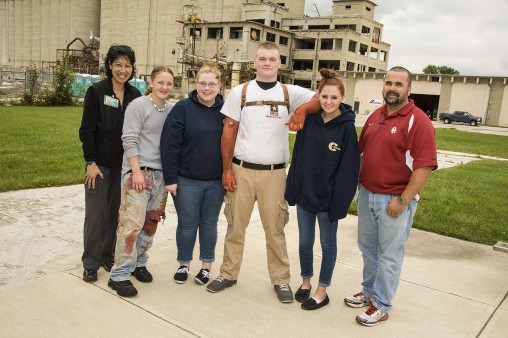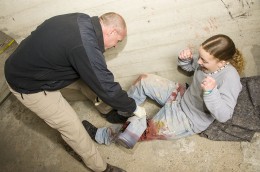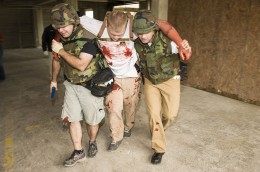
From left: Stephanie Davis, associate professor of leadership studies and director of Career, Technical & Adult Education; GCCC students Adeela Boyd, Tori Catterlin, Zach George and Deena Vanover; and John Demmitt, GCCC criminal justice instructor.
Is there a better way to learn firsthand about homeland security and the link it has to medical preparedness than to serve as role players in a medical training course for law enforcement professionals? After their eye-opening experience last week at Wright State University’s Calamityville, four criminal justice students from Greene County would say no.
On Sept. 11 and 12, seniors from Greene County Career Center’s (GCCC) Criminal Justice program participated as medical role models in a collaborative effort between Wright State’s Career, Technical & Adult Education teacher licensure program, the GCCC program and the National Center for Medical Readiness (NCMR) at Calamityville.
Stephanie Davis, Ph.D., associate professor of leadership studies and director of Career, Technical & Adult Education, collaborated with Jim Gruenberg, deputy director of NCMR, to determine authentic learning experiences for career tech students that align with state program standards for criminal justice and career tech teacher licensure areas.
“Working with NCMR is a natural fit for students in career tech programs such as law and public safety, health science, transportation systems and arts and communication,” said Davis. “At Calamityville, students are able to see how their career tech program fits in with the larger disaster response picture.”
Davis added that learning in a hands-on environment with professionals in related career fields helps students make connections and become engaged in learning as well as workforce ready at a younger age.
Gruenberg has been proactive about linking career tech programs to NCMR because he sees the value of early involvement in workforce career opportunities.
Criminal justice students began with moulage — the application of mock injuries, followed by an orientation and safety briefing before moving to a training zone. Jack Smith, associate director for Emergency Management & Response Operations and a moulage expert, applied moulage to students to help them understand their roles as models during the training exercises.
Law enforcement professionals then worked with student “models” and interacted with them during rescue exercises at Calamityville, a unique setting of concrete buildings filled with passageways, machinery, and open areas to simulate industrial and commercial settings.
NCMR provides medically oriented education, training, product testing and research opportunities for medical and non-medical civilian and military personnel.
During the two days, students worked with professionals in law enforcement, firefighting, and federal government personnel. Students were asked questions about their injuries and were transported to a safe location by being carried over a shoulder or lifted in a blanket and transported down a flight of stairs.
“Getting to see what it’s like in the real world, the environment (at Calamityville) it’s so overwhelming. You could be anywhere and something could go wrong,” said Zach George, GCCC senior who plans to begin training in 2015 to become a U.S. Marine. “The experience gave me an idea of what emergency responders have to go through every day. I appreciate what they do that much more.”
“I learned you need to take it (disasters) seriously — it could be you in this life situation,” said Adeela Boyd, GCCC senior.
John Demmitt, criminal justice instructor at GCCC, is looking forward to continual collaborative efforts that provide authentic experiences to his students in homeland security and medical readiness.
“On the way back to GCCC, students couldn’t stop talking about the day’s experiences,” said Demmitt. “They want more — it was fun, and they learned a lot about staying calm, being professional, and how to apply concepts we have been learning in Criminal Justice such as the need to evaluate a scene and injuries in order to address the problem and provide an appropriate response.”
“This was the perfect opportunity to link the university and our community at large in a very unique and intentional way,” said Gruenberg. “We certainly look forward to leveraging this success for future opportunities. And besides, the kids did great!”



 Wright State alum Lindsay Aitchison fulfills childhood space-agency dream
Wright State alum Lindsay Aitchison fulfills childhood space-agency dream  Wright State business professor, alumnus honored by regional technology organizations
Wright State business professor, alumnus honored by regional technology organizations  Wright State University Foundation awards 11 Students First Fund projects
Wright State University Foundation awards 11 Students First Fund projects  Gov. DeWine reappoints Board Treasurer Beth Ferris and names student Ella Vaught to Wright State Board of Trustees
Gov. DeWine reappoints Board Treasurer Beth Ferris and names student Ella Vaught to Wright State Board of Trustees  Joe Gruenberg’s 40-Year support for Wright State celebrated with Honorary Alumnus Award
Joe Gruenberg’s 40-Year support for Wright State celebrated with Honorary Alumnus Award 